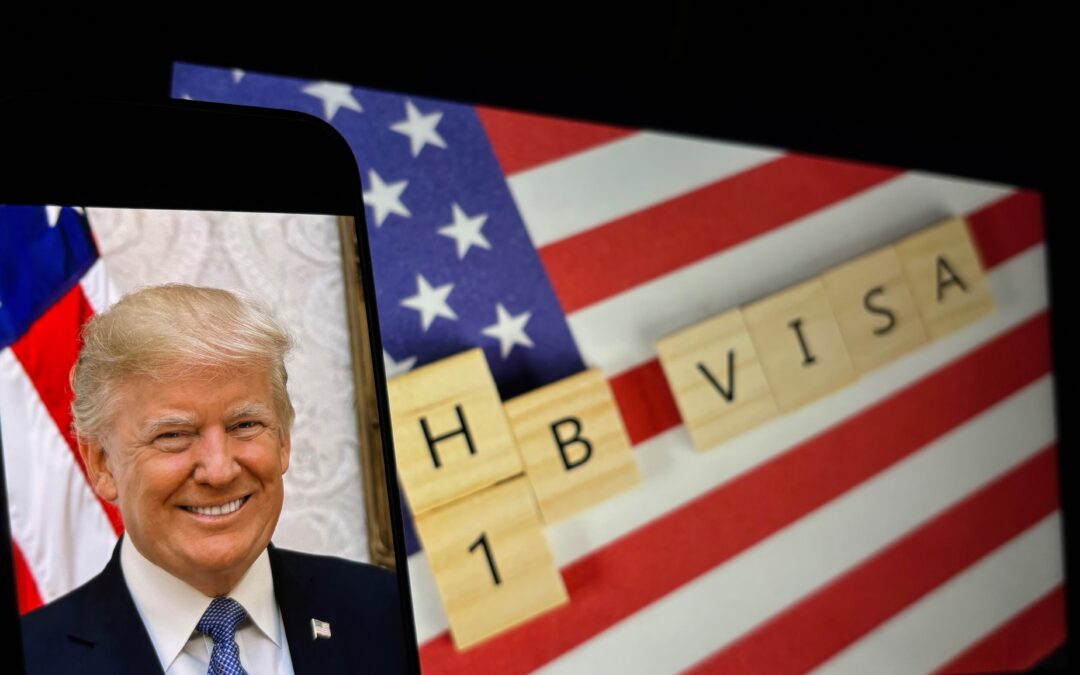Last Friday, President Trump shocked the media world once again by announcing a new $100,000 fee for holders H-1B visas.
This kind of move is wholly unprecedented, even for Trump. But once you get past the “sticker shock” of its high price tag, you’ll start to see how this move could put billions in the pockets of American citizens — at the stroke of a pen.
Hit the video below to get started:
Video transcript:
This is Moneyball Economics. I’m Andrew Zatlin, and today we’re going to talk about yet another motion by Donald Trump to reshape the US economy.
In this case, we’re looking at the labor market and specifically at a certain type of immigration rule called the H-1B visa.
The H-1B visa was created to fast-track the access of specialized skills that we couldn’t currently in the United States fulfill. So we’ve got a shortage of certain skills. We need them, they’re offshore. Bring in those people with these special skills. We’ll fast track them. Even better, they’re going to go to the front of the line when it comes to applying for a green card.
So in theory, this is meeting a very dire American need. In reality, it’s a scam that is abused by high tech companies.
I have some secondhand knowledge here because a friend of mine was a lawyer in Silicon Valley, and guess what? Her entire job was to help these high-tech companies short circuit the rules so they could hire more of these H-1B visa holders.
Let me start with some facts. The H-1B visa is held by 700,000 workers in the United States. Think about that. It says that currently the United States has a shortage of 700,000 people to do certain work. Well, what is that work? Well, apparently it’s almost all software engineering and other STEM type of capabilities.
71% of H-1B visa holders in the United States come from India, 12% from China. Every year, another 85,000 visas are extended.
The reality is this is loved by high tech companies for the cost savings. Let me give you an example. Amazon has 10,000 employees, 20% of their software engineering base who are H-1B visa holders, Google 5,000, apple, 5,000, meta, 5,000, JP Morgan, and on and on and on.
This is a massive way to cut costs and outsource from American workers the tasks, but do it in a real novel way.
Yes, Amazon could outsource their software engineering needs to a company resident in say, India. There’s an advantage though, to having that individual here in the United States. There’s time zone advantages and there’s basically managerial productivity advantages. You can see the person, you can track their work a lot better … and you can underpay them.
The average salary for an H-1B visa holder is $108,000. By comparison, the same work done by an American software engineer, say in Silicon Valley is going to be almost $200,000. There’s a $100,000 per person savings that Amazon and Google and so on are pocketing.
So for Amazon with 10,000 H-1B visa holders, and a savings of a hundred thousand each — this is a billion dollars of cost cutting that Amazon is enjoying currently!
Well, the Trump administration is definitely interested in increasing onshore jobs. That’s what they’ve been doing with their tariffs, and they have gone on the attack against the H-1B visa. They were going on the attack as part of Trump’s campaign promises, because he sees it for what it is.
He knows it’s a scam by high tech companies to not just keep down the cost of the employees that they’ve hired, but it’s a wonderful cudgel. It’s leverage against your other American citizens to say, “look, if you don’t like the salary we’re giving you, you can always bring in someone from India.”
Donald Trump didn’t like this, and so early on in his administration, he went on the attack. The first thing he did was he cut part of the loophole out. Remember, these are supposed to be visas extended to people with specialized skills, real senior type of stuff. Instead, they were going to junior entry level engineers.
So earlier this year, the Donald Trump administration cut that out entirely.
No more entry level engineers could come in on an H-1B Visa. Last week he did a second attack. He said, anyone coming in applying for the H-1B visa will pay a hundred thousand dollars each. So with 85,000 applicants, that’s an $8.5 billion hit. And who pays it? Well, the companies that bring them in are going to pay it.
Frankly, I kind of like that.
It injects more money into the economy. It helps local taxes and so forth. I don’t care if Google and Amazon have to take some money off their balance sheets. I like the way that this would work for the US economy, and it has a way of boosting US citizens and their payrolls, their wages. Excuse me, and let’s face it, if you can take 85,000 jobs and give them to American citizens, that’s kind of cool too.
Now, why did it come out last week?
After all a month ago, Donald Trump had his high-tech moguls come to the White House where they partied it up. They were all surprised last week when Donald Trump made this announcement. So clearly this is something that hasn’t been vetted by high tech companies, even though they are the most affected.
I believe that that was a secondary issue, how it impacts high tech companies, because let’s face it, Donald Trump has a lot of leverage over them. Where I think the real target was India…
Currently, Donald Trump wants India to help him with Russia, and they’re not playing ball. India is the primary source of these jobs for Donald Trump. Cutting into this means cutting into billions of dollars for India and forcing the decision. Ultimately, all this really is at the end of the day, putting aside any kind of back room type of shenanigans, like getting leverage over high tech companies or India.
At the end of the day, this quite frankly is a platform that Democrats love and they’ve been trying to get to as well, bring back American jobs for Americans.
It’s remarkable that going into the next year, Donald Trump is going to have a big win in his pocket because he can go out there and say, “Joe Biden didn’t do this in four years. I did it in my first year!”
Lots of wins here for Trump, but I believe that this is part and parcel of his whole goal of Onshoring jobs any way he can. This is basically this a hundred thousand dollars hit is basically just a tariff, just like you would tariff steel imports. He’s saying, these people coming on H-1B visas, for better or worse, are essentially imported labor and we’re going to put a tariff on them.
I don’t think this is the end of what Donald Trump wants to do with the labor market.
I’m guessing that next year after the election year is done, he’s going to come out and he’s going to start revisiting the jobless benefits that America provides. See in Donald Trump’s mind, he’s creating jobs. The tariffs are creating jobs in the manufacturing space. Here, he’s creating jobs by blocking foreign workers from coming to the United States and forcing the Amazons of the world to hire American citizens.
He’s creating jobs, and in his mind, when he looks out there at the JOLTS data and he sees all these job openings, and then off on the side, he sees all these people who are saying, I can’t get a job. Well, he’s going to say, this can’t continue. There are more job openings out there than there are people applying for jobs. So there’s plenty of jobs out there.
If you don’t have one that’s kind of a “you” problem, this is where I think Donald Trump is going to go. I’m not saying it’s right or wrong. I’m not saying that’s all he’s going to do. Maybe he comes up with programs to help people get the skills to get these jobs.
At the end of the day, Donald Trump is going to make some more motions in the labor market that try to create a stronger labor market, more demand and more supply. And it’s very interesting to watch because this is foundational for the economy. See how it plays out.
In the meantime, we are in it to win. It.
Zatlin out.

Andrew Zatlin
Editor, Moneyball Economics





